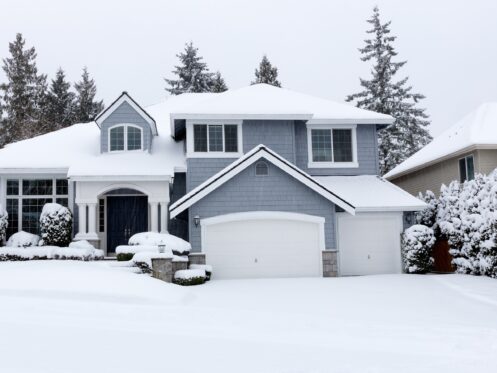Winter weather, with its heavy snow and ice, can take a serious toll on your roof, potentially leading to costly repairs. The weight of snow and ice can also put your family and home in danger. Taking the proper preventative measures can protect your home during the winter.
Schedule Professional Roof Maintenance
Annual roof maintenance is a critical step in preparing your home for winter and preventing costly damage. During maintenance, a roofer inspects all aspects of your roof, including your attic, to identify potential issues. They inspect for leaks, damaged shingles or flashing, and structural problems. Addressing these vulnerabilities helps ensure your roof can withstand the added weight of heavy snow and ice that comes with winter.
During a professional inspection, roofers typically assess the following key areas:
- Condition of roofing materials
- Flashing
- Gutters
- The sealing around roof protrusions
You should schedule a roof inspection each year in late summer or early fall. Addressing problem areas will ensure your roof is in sound shape for winter.
Clean Your Gutters
Equally important to having your roof inspected is cleaning out your gutter system. Clean and functional gutters are essential for proper water drainage. Clogged or damaged gutters can lead to the formation of ice dams. Ice dams are ice blockages that prevent melting snow from draining off the roof.
For instance, if your gutters are clogged with leaves and debris, melting snow can accumulate and refreeze along the eaves, forming an ice dam. This dam traps additional water behind it, forcing it under the shingles and onto the roof sheathing. Over time, this can lead to warped or rotting decking, damaged shingles, and loose flashing. Left unaddressed, the water may seep into your attic, causing leaks that result in stained ceilings and damaged walls inside your home.
Check for Proper Attic Ventilation
Attic ventilation is critical for maintaining roof temperature during the winter. Proper ventilation keeps the attic from becoming too warm. When the attic becomes overly warm, the ice and snow on the roof can melt and refreeze at the edge, contributing to ice dam formation.
You should regularly check your attic vents and fans for blockages preventing airflow. Adequate ventilation can also protect your attic from condensation, which can lead to mold growth.
Upgrade Your Attic Insulation
Proper attic insulation is crucial for protecting your roof during winter. It minimizes heat loss from your home, helping to regulate roof temperatures and prevent uneven snowmelt. High-quality insulation also improves energy efficiency, keeping your home warmer while reducing heating costs.
To enhance insulation performance, seal gaps around light fixtures, ductwork, and plumbing penetrations. Even small openings can allow heat from your home to escape into the attic, creating temperature imbalances that may lead to winter roofing issues.
For added protection, consider installing a thermal roof barrier on the underside of your roof rafters. These barriers reflect rising heat within the attic, preventing it from warming your roof.
Install Snow Guards and Roof Heating Systems
Snow guards effectively prevent injuries and property damage in climates where heavy snow frequently occurs. These metal barriers hold back the majority of snow or ice, preventing large sheets from falling suddenly and causing injuries or damage. They also allow the melting snow and ice to drip through the barrier and into the gutter drainage system.
Alternatively, roof heating cables are an effective way to manage snow and ice on your roof. These cables generate heat to melt snow and ice, creating channels that allow water to flow off the roof instead of pooling and refreezing. Professional installation is essential to ensure the cables are positioned correctly for optimal performance, and an annual inspection is recommended to confirm they remain in good working condition.
Trim Tree Branches
Trees near your home can significantly increase the risk of roof damage during the winter. Dead or weakened branches may snap under the weight of heavy snow, potentially falling on your roof and causing structural damage. To prevent this, trim branches back to a safe distance of at least 6 to 10 feet from your roof. This clearance minimizes the risk of falling debris and reduces the amount of leaves and twigs accumulating in your gutters. Late summer or early fall is the ideal time for trimming. This timing allows trees to recover before the onset of colder weather.
Use the Right Snow Removal Tool
Removing snow from your roof is a challenging task, but having the right tool can make all the difference. As snow accumulates, it can place heavy weight on your roof, potentially leading to damage or even collapse in extreme cases. A roof rake is a safe and effective tool that allows you to remove snow while staying safely on the ground.
Look for a snow rake with a telescoping handle and a plastic blade to avoid damaging your shingles. Never use metal rakes, as they can scratch or tear the roofing material. Begin clearing snow from the roof edges, working in small sections. Gradually move upward to prevent pulling down too much snow at once. Always ensure you’re standing on a stable surface and maintaining a safe distance from the roof.
It’s important to remove snow after each significant snowstorm rather than waiting until it builds up too much. Regular snow removal will make the process easier and safer. If snow accumulation becomes too deep during an extreme storm, consider hiring a professional snow removal service to avoid safety risks.
Consider a Roof Upgrade
Certain roof materials, including metal, can withstand heavy snow and ice better than others. If your roof is older, consider upgrading before winter to avoid damage from snow and ice.
Metal roofs are highly durable, and their slick surface allows snow to shed, preventing buildup. Proper care ensures that a metal roof lasts 40 to 70 years.
Asphalt shingles with enhanced weather resistance can also help protect your roof. Consider shingles that are impact-resistant or cold-weather-durable. A professional roofer can help you select the best roofing materials to protect your roof against the rigors of winter.
Know the Signs of Roof Problems
Recognizing early signs of roof damage is crucial to addressing issues before winter weather makes them worse. Start by inspecting your walls and ceilings for wet or stained areas, especially during rainstorms. Additionally, keep an eye out for the following warning signs:
- Damaged or missing shingles
- Roof sagging
- Light coming through the attic
- Granules in the gutters
You should also monitor your roof during a heavy snowstorm. Creaking or popping sounds mean your roof is under strain. Check for sagging. If you notice one of these signs, contact a roofing company immediately to prevent catastrophic roof damage.
Contact Your Local Roofing Experts
At Emerald Roofing, we have been serving the residents of Omaha, NE and the surrounding areas since 2010. We install, maintain, and repair roofs to make your home safe, comfortable, and beautiful. We can also help with all your siding and gutter needs. Contact us today to schedule an appointment with one of our experienced roofers.
Contact Emerald Roofing today!

